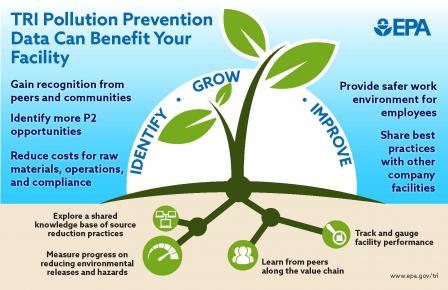Pollution Prevention (P2) and TRI
 Under the Pollution Prevention Act of 1990 (PPA), the Toxics Release Inventory (TRI) Program collects information to track industry progress in reducing waste generation and moving towards safer waste management alternatives. Many facilities provide descriptions of measures they have taken to prevent pollution and reduce the amount of toxic chemicals entering the environment. As a result, TRI serves as a tool for identifying effective environmental practices and highlighting pollution prevention successes.
Under the Pollution Prevention Act of 1990 (PPA), the Toxics Release Inventory (TRI) Program collects information to track industry progress in reducing waste generation and moving towards safer waste management alternatives. Many facilities provide descriptions of measures they have taken to prevent pollution and reduce the amount of toxic chemicals entering the environment. As a result, TRI serves as a tool for identifying effective environmental practices and highlighting pollution prevention successes.
Access TRI's P2 Data
- Use the TRI P2 Search Tool to get info by industry sector, chemical, geography or parent company, and compare environmental performance.
- Use the Industry Profile Dashboard to explore TRI information for a particular industry, including the food, automotive and pharmaceutical manufacturing sectors.
- Download Excel files of all TRI P2 data
Learn About TRI P2 Resources
- Browse P2 Analyses and Publications for information on P2 opportunities and the benefits of P2 implementation.
- Browse TRI's collection of P2 resources, including factsheets, videos, tips for reporting P2 activities to TRI, and how-to guidance for conducting analyses with the TRI P2 Search Tool.
Source Reduction Activities Reported to TRI
For 2018, a total of 1,270 facilities (6% of all TRI facilities) reported initiating 3,120 new source reduction activities. Good operating practices, process modifications, and spill and leak prevention were the activities reported most frequently. Click on the legend to see examples of source reduction activities; reported codes are included in parentheses.
 Good Operating Practices
Good Operating Practices
- A circuit board manufacturing facility reported periodic maintenance of equipment that helps minimize overdosing ammonia into the process. (W13)
- A metal forming and laser cutting facility used enhanced process monitoring and quality control to improve its resource utilization and reduce the scrap metal (containing nickel) generated. (W15)
Return to Source Reduction Activities Graph or Top of Page
 Process Modifications
Process Modifications
- A boat manufacturer optimized the efficient use of styrene by adding equipment to conduct some molding operations under closed conditions. (W50)
- A computers and electronics products facility validated new products with aqueous methods to decrease the amount of methanol usage. (W56)
Return to Source Reduction Activities Graph or Top of Page
 Spill and Leak Prevention
Spill and Leak Prevention
- An inorganic chemical manufacturing facility implemented procedures to prevent leaks of boron trifluoride by improving maintenance and inspection requirements for its outdoor storage tanks. (W39)
- A frozen food manufacturer reduced its ammonia usage by upgrading compressor seals and o-rings in top fugitive emissions areas to reduce losses. (W39)
Return to Source Reduction Activities Graph or Top of Page
 Inventory Control
Inventory Control
- A gravure printer reduced toluene use through paint scrap tracking and paint reuse programs. (W21)
- A ship manufacturer reduced styrene waste by ensuring that resins were used before expiration. (W21)
Return to Source Reduction Activities Graph or Top of Page
 Raw Material Modifications
Raw Material Modifications
- A plastics product manufacturer reformulated their liquid polyester resin to a zero-styrene alternative resin type. (W42)
- An automobile parts manufacturer is moving away from PVC materials which use antimony trioxide as a fire retardant to thermoplastic polyolefin (TPO)-type materials to meet customer demands. The facility continues to test alternative fire retardants to use in its products. (W42)
Return to Source Reduction Activities Graph or Top of Page
 Product Modifications
Product Modifications
- A circuit board manufacturing facility began offering alternative product finishes to customers to reduce the use of lead finish in its product. The facility also changed product specifications to minimize the amount of rework required in production, further reducing unnecessary use of lead for metal coating. (W81)
- An oil and grease product manufacturer eliminated the use of toluene in its formulas as part of a plant-wide "Lubricants for a Healthier Planet" product strategy. (W82)
Return to Source Reduction Activities Graph or Top of Page
 Cleaning and Degreasing
Cleaning and Degreasing
- A rubber products manufacturer changed the start time for a process so that it was based on production volume instead of production time, reducing the facility’s use of nitrate compounds. (W64)
- A paint and coating manufacturer improved manual solvent wash operations by monitoring solvent use during cleaning operations which resulted in reduced toluene usage by 7,000 gallons compared to the prior year. (W71)
Return to Source Reduction Activities Graph or Top of Page
 Surface Preparation and Finishing
Surface Preparation and Finishing
- A heating equipment manufacturer improved its painting process by installing additional robotic painting equipment which reduced its xylene emissions. (W72)
- A motor vehicle parts manufacturer upgraded a surface treatment machine to a new chemical etching process which resulted in fewer bath dumps and therefore less acid usage. (W78)
Return to Source Reduction Activities Graph or Top of Page
